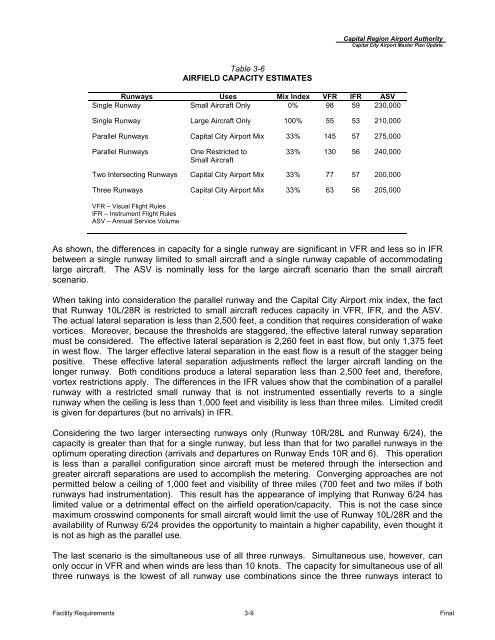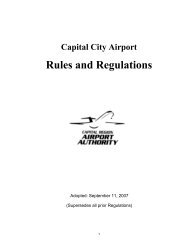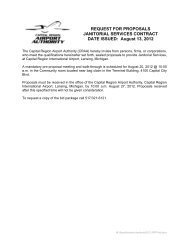Master Plan Update (pdf) - Lansing/Capital City Airport
Master Plan Update (pdf) - Lansing/Capital City Airport
Master Plan Update (pdf) - Lansing/Capital City Airport
You also want an ePaper? Increase the reach of your titles
YUMPU automatically turns print PDFs into web optimized ePapers that Google loves.
Table 3-6<br />
AIRFIELD CAPACITY ESTIMATES<br />
<strong>Capital</strong> Region <strong>Airport</strong> Authority<br />
<strong>Capital</strong> <strong>City</strong> <strong>Airport</strong> <strong>Master</strong> <strong>Plan</strong> <strong>Update</strong><br />
Runways Uses Mix Index VFR IFR ASV<br />
Single Runway Small Aircraft Only 0% 98 59 230,000<br />
Single Runway Large Aircraft Only 100% 55 53 210,000<br />
Parallel Runways <strong>Capital</strong> <strong>City</strong> <strong>Airport</strong> Mix 33% 145 57 275,000<br />
Parallel Runways One Restricted to<br />
Small Aircraft<br />
33% 130 56 240,000<br />
Two Intersecting Runways <strong>Capital</strong> <strong>City</strong> <strong>Airport</strong> Mix 33% 77 57 200,000<br />
Three Runways <strong>Capital</strong> <strong>City</strong> <strong>Airport</strong> Mix 33% 63 56 205,000<br />
VFR – Visual Flight Rules<br />
IFR – Instrument Flight Rules<br />
ASV – Annual Service Volume<br />
As shown, the differences in capacity for a single runway are significant in VFR and less so in IFR<br />
between a single runway limited to small aircraft and a single runway capable of accommodating<br />
large aircraft. The ASV is nominally less for the large aircraft scenario than the small aircraft<br />
scenario.<br />
When taking into consideration the parallel runway and the <strong>Capital</strong> <strong>City</strong> <strong>Airport</strong> mix index, the fact<br />
that Runway 10L/28R is restricted to small aircraft reduces capacity in VFR, IFR, and the ASV.<br />
The actual lateral separation is less than 2,500 feet, a condition that requires consideration of wake<br />
vortices. Moreover, because the thresholds are staggered, the effective lateral runway separation<br />
must be considered. The effective lateral separation is 2,260 feet in east flow, but only 1,375 feet<br />
in west flow. The larger effective lateral separation in the east flow is a result of the stagger being<br />
positive. These effective lateral separation adjustments reflect the larger aircraft landing on the<br />
longer runway. Both conditions produce a lateral separation less than 2,500 feet and, therefore,<br />
vortex restrictions apply. The differences in the IFR values show that the combination of a parallel<br />
runway with a restricted small runway that is not instrumented essentially reverts to a single<br />
runway when the ceiling is less than 1,000 feet and visibility is less than three miles. Limited credit<br />
is given for departures (but no arrivals) in IFR.<br />
Considering the two larger intersecting runways only (Runway 10R/28L and Runway 6/24), the<br />
capacity is greater than that for a single runway, but less than that for two parallel runways in the<br />
optimum operating direction (arrivals and departures on Runway Ends 10R and 6). This operation<br />
is less than a parallel configuration since aircraft must be metered through the intersection and<br />
greater aircraft separations are used to accomplish the metering. Converging approaches are not<br />
permitted below a ceiling of 1,000 feet and visibility of three miles (700 feet and two miles if both<br />
runways had instrumentation). This result has the appearance of implying that Runway 6/24 has<br />
limited value or a detrimental effect on the airfield operation/capacity. This is not the case since<br />
maximum crosswind components for small aircraft would limit the use of Runway 10L/28R and the<br />
availability of Runway 6/24 provides the opportunity to maintain a higher capability, even thought it<br />
is not as high as the parallel use.<br />
The last scenario is the simultaneous use of all three runways. Simultaneous use, however, can<br />
only occur in VFR and when winds are less than 10 knots. The capacity for simultaneous use of all<br />
three runways is the lowest of all runway use combinations since the three runways interact to<br />
Facility Requirements 3-9 Final




